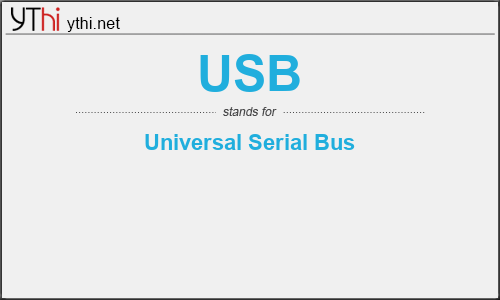What does USB mean? What is the full form of USB?
The full form of USB is Universal Serial Bus.
The Universal Serial Bus (USB) standard was originally developed in 1995, to minimize the number of ports in the back of the PC. The major goal of USB was to define an external expansion bus which makes adding peripherals to a PC low cost and as easy as hooking up a telephone to a wall-jack. USB featured a maximum bandwidth of 1.5Mbit for low speed devices such as mice and keyboards, and a maximum bandwidth of 12Mbit for higher speed devices such as web cams, printers, scanners and external CD-RW drives. Frustrated by Apples royalty fees on firewire devices, in April 2000, seven industry-leading companies, consisting of Compaq, Hewlett Packard, Intel, Lucent, Microsoft, NEC, and Philips published the specifications for USB2.0. It has taken approximately 2 years for USB 2.0 to become adopted as a mainstream USB1.1 replacement. In just a few short months USB 2.0 will be the high speed PC peripheral connectivity choice over IEEE-1394.
The USB 2.0 specification extends the maximum speed of the connection from 12 Mbps on USB 1.1 up to 480 Mbps (60MBytes/sec). This enables the transfer of 1920×1080 images at 24fps (frames per second) for high-definition video conferencing or 320×240 images at 500fps for high speed video motion analysis. The transition to USB 2.0 will be seamless, since USB 2.0 is both forward and backward compatible with USB 1.1. Older peripherals will simply plug into new USB 2.0 capable PCs and Hubs. The USB connectors and cables are even identical. It is even possible for a high speed USB 2.0 device to plug into a legacy USB1.1 port and simply operate at reduced throughput. Both Hi-Speed USB 2.0 and original USB 1.1 peripherals can operate on a computer at the same time. The new USB 2.0 expansion hub design manages the transition of the data rates between the high speed host and lower speed USB peripherals, while maintaining full bandwidth utilization. Up to 127 USB peripherals with 5 levels of hubs can be connected to a single USB host controller. With 5 Meters (16.4 feet) of cabling between devices, a network of cameras, sensors, data acquisition, and I/O devices can physically extend up to 30 Meters (98 feet) from the PC. A peripheral can either be self-powered or bus-powered, with up to 500mA of consumption. To satisfy the needs of low-power embedded and portable computer applications, a power-management mechanism is also incorporated.
USB has benefits for everyone. It helps to reach the first time PC consumer by overcoming usability barriers through easy peripheral installation. The end user has a more rewarding and productive experience.
Below is a table of current capabilities that USB has to offer:
| Feature | Benefit |
| Easy to Use | Simply plug it in – everything configures automatically. True Plug-and-Play! Connect and reconnect peripherals without rebooting your PC. |
| Expandable | Plug as many as 127 peripherals into one computer using USB multi-port hubs. |
| Speedy | 100 times faster than serial ports — up to 12 Mbits/second. With new USB 2.0 standards coming, the new target speed is 480 Mbits/second. |
USB
means
Universal Serial Bus![]()
Translate Universal Serial Bus to other language.


Leave a Reply
You must be logged in to post a comment.